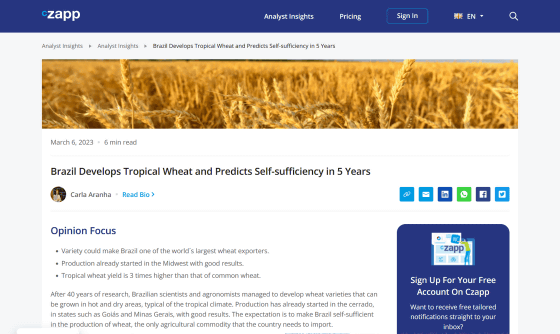Brazil develops `` tropical wheat '' with the potential to increase yields up to three times, and the possibility of achieving self-sufficiency in wheat and becoming one of the world's leading exporters

Brazil is one of the world's leading agricultural powerhouses and is an exporter of various agricultural products, including cereals. Under such circumstances, 'tropical wheat' developed by Brazil over 40 years of research is attracting attention as it has the potential to boost Brazil to one of the world's leading wheat exporters at once.
Brazil Develops Tropical Wheat and Predicts Self-sufficiency in 5 Years | Czapp

Czapp , a trade-related media operated by international sugar broker Czarnikow , has published an article featuring `` tropical wheat '', a wheat variety developed by Brazilian scientists and agronomists. According to Czapp, tropical wheat is a suitable variety for growing in hot, dry climates and is expected to lead to self-sufficiency in wheat, the only agricultural product Brazil imports.
Cultivation of tropical wheat has already started in the Midwestern part of Brazil, and one producer in Goias State has achieved a yield of 9.63 tons per hectare, which is three times the national average. By popularizing tropical wheat and increasing wheat production, Brazil has become one of the world's leading countries, along with the EU, which accounts for about 17% of the world's wheat shipments, Russia, which accounts for about 16.4%, and Australia, which accounts for about 13.7%. has ambitions to become one of the world's leading wheat exporters, reports Czapp.

Brazil is a major importer of wheat, importing more than 10 million tons of wheat annually, but domestic production increased from 6.2 million tons in 2019 to 10 million tons in 2022. It seems that the main factor is not the variety of wheat, but the increase in the cultivated area in southern Brazil, which accounts for 90% of wheat production, but the grassland spreading in the Midwest, which accounts for about 10% of wheat production. (
The Brazilian Agricultural Research Corporation (Embrapa), a state-owned corporation under the Ministry of Agriculture that developed tropical wheat, has been working on breeding wheat for about 40 years, and since the 2010s has focused on researching wheat adapted to tropical climates. . According to Celso Moretti, president of Embrapa, Embrapa ordered varieties adapted to environments with high temperatures and poor water resources from Mexico, Argentina, Europe, America, etc., and crossed them with varieties in Brazil to test them. About.
Moretti points out that wheat, which is the raw material for bread and pasta, is a very important food for food security. With the war between Ukraine and Russia affecting wheat exports and rising wheat prices on the international market, it makes sense to increase domestic wheat production. In addition, tropical wheat has a protein content of 15%, which is nearly twice that of average wheat, and has the advantage of high quality.
In addition, the cultivation of tropical wheat in the Cerrado takes place from March to June, which is out of season with other major crops such as maize and soybeans, which provides an additional source of income for farmers.

However, in order for farmers in the Midwestern part of Brazil to actually start cultivating tropical wheat, there are several issues to be resolved, one of which is ``attracting wheat milling factories to the Midwestern part.'' Brazil traditionally relied on imports for much of its wheat, so many of its flour mills are located in coastal areas, and it is necessary to encourage entrepreneurs to build mills in the Midwest.
For entrepreneurs to build flour mills in the Midwest, it is important to know that tropical wheat yields and quality are reliable, and that they can be sold in the market at a profitable price. ``Last year, about 10 million tons of wheat were produced domestically in Brazil, of which 3 million were exported,'' Moretti said. If the situation in the international market continues, I imagine that the global market will heat up further.'

Related Posts:







